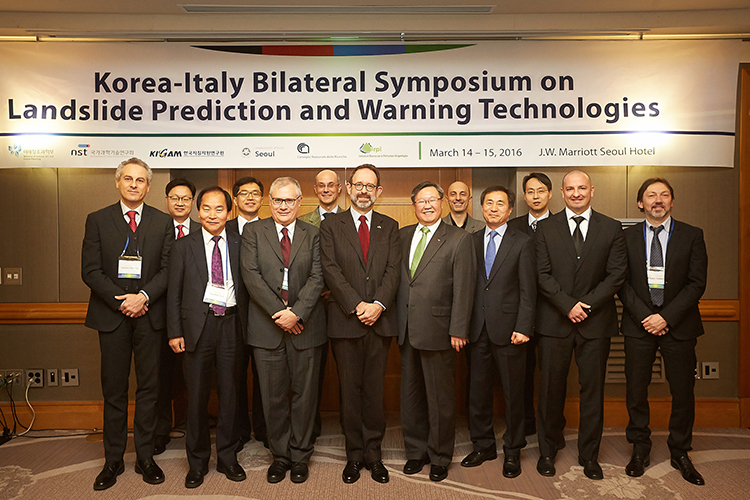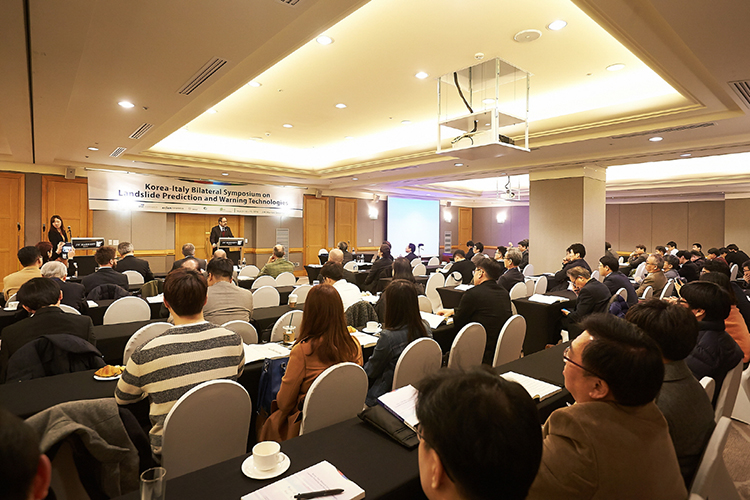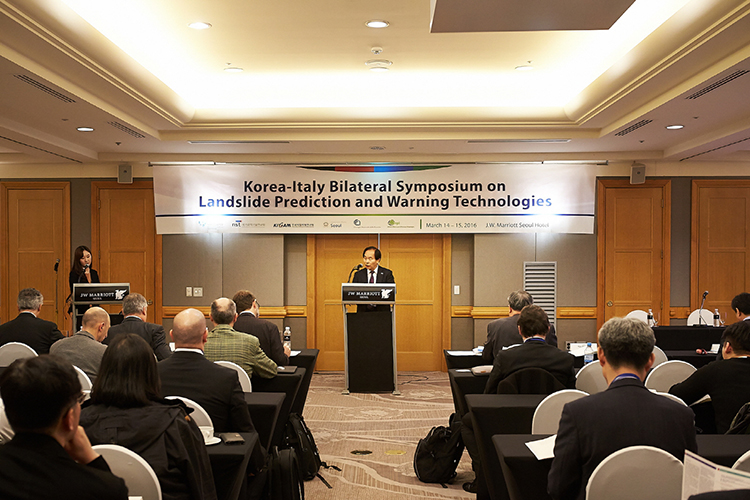- Nameadmin
- Date2016/03/25 00:00
- Hit2,676
Korea and Italy Hold a Symposium on Landslide Early Warning Technology
- Presenters from landslide disaster research institutes in Korea and Italy discuss their latest research.
- Symposium sets the groundwork for science and technology collaboration between the two countries for landslide prediction, observation, and warning.
The “Korea-Italy Landslide Early Warning Technology Symposium” was held at the Seoul JW Marriott Hotel on the 14th, sponsored by the Korean Institute of Geoscience and Mineral Resources (KIGAM, President Kyu Han Kim) under the aegis of the Ministry of Science, ICT and Future Planning, the Embassy of Italy in Korea (Ambassador Marco della Seta), and the National Research Council of Science & Technology (Chairman Sangchun Lee). The symposium will take place over two days up to the 15th, with leading experts from Korean and Italian research institutions and universities presenting the outcomes of their latest research related to landslide disasters.
The purpose of this symposium was to promote research collaboration between Italy and Korea, as envisioned by the MOU signed in 2014 between Korea’s National Research Council of Science & Technology (NST) under aegis of the Ministry of Science, ICT and Future Planning and Italy’s Consiglio Nazionale delle Ricerche (CNR) as well as the MOU for research collaboration in landslide early warning technology that was signed in 2015 between the Korean Institute of Geoscience and Mineral Resources and the Research Institute for Geo-hydrological Protection (IRPI) under Italy’s CNR.
Korea and Italy have respectively conducted a variety of studies regarding landslide disasters. Italy in particular is a country that is globally renowned for its pioneering research in the field of landslide disasters.
Similar to the case in Korea, Italy has also suffered repeatedly from landslides of varying scales, small and large, which occur each year according to the conditions of topography, geology, and rainfall. The Italian government classifies landslides as a major natural disaster that threatens the safety of its citizens. Notably, the SANF system (an acronym for Italy’s national early warning system for rainfall-induced landslides operated by IRPI) is reputed to be the best landslide early warning system in the world.
Korea has also suffered annually from serious losses of lives and property caused by large scale landslides such as those that occurred in Umyeon-san and the pension in Chuncheon, and in response, there have been ongoing research and development efforts to secure the technology for performing accurate prediction and early warning of landslides. The Korean Institute of Geoscience and Mineral Resources has taken the lead in building a real-time landslide monitoring system in areas with major national parks and conducting active research to develop landslide warning criteria suitable for Korea’s environment.
A total of 10 experts presented at this symposium, representing 9 research institutions and universities in Korea and Italy that specialize in landslide disasters.
Participants from Korea included experts from the Korean Institute of Geoscience and Mineral Resources as well as the Korea Forest Research Institute, National Disaster Management Institute, Sejong University, and Gangneung-Wonju National University, who presented their latest research findings and discussed national response measures for landslide disasters.
Italian participants included researchers from IRPI, University of Florence, University of Bologna, and University of Milan, who presented the latest research techniques used in Italy in relation to landslides. These Italian presenters were globally renowned researchers pioneering advancements in the field of landslide disasters, and they offered those at the symposium valuable opportunities to examine current research and technology in Italy.
Up to the mid 2000’s, researchers in both Korea and other countries mainly focused on spatial vulnerability analysis techniques to predict spots that were vulnerable to landslides. More recently, however, there have been initiatives to research and develop spatial and temporal landslide prediction and early warning techniques that use such spatial information to identify when and where a landslide will occur.
In Italy, research institutions and universities jointly developed Landslide Early Warning Technology based on rainfall and ground displacement, which has reached the stage of practical implementation. IPRI actually uses the SANF system to issue Landslide Early Warnings covering all regions of Italy.
Korea has also undertaken active research to develop landslide warning technology, with the support of the institutions such as the Ministry of Science, ICT and Future Planning, the Korea Forest Service, and the Ministry of Public Safety and Security. Building on the outcomes of research conducted by the Korean Institute of Geoscience and Mineral Resources and the Korea Forest Research Institute, the Korean National Disaster Management Institute, and the Research Group on Core Technology Development of Real-Time Prediction and Counterplan for Extreme Rainfall-Induced Landslide Disaster of the Ministry of Science, ICT and Future Planning, Korea hopes to enhance the precision of the domestic landslide warning criteria and set the technological foundation for operating a nationwide, reliable early warning system.
Since 2014, the Korean Institute of Geoscience and Mineral Resources has used the results of research conducted through major projects of various institutions and the Project for Core Technology Development of Real-Time Prediction and Counterplan for Extreme Rainfall-Induced Landslide Disaster to build a landslide real-time monitoring system in national park regions, in partnership with the Korea National Park Service. This data is used as the basis for the research and development of landslide warning criteria customized for the rainfall and geological conditions of Korea.

President Kyu Han Kim of the Korean Institute of Geoscience and Mineral Resources observed that “Securing the technology for accurately predicting landslides and issuing early warnings is essential and urgently needed to safeguard our society.” He added, “We will continue to collaborate in research with the world’s leading expert research institutes to maximize the reliability and practical feasibility of our technology for predicting landslides and issuing early warnings. We will do our best to ensure the safety of our citizens.”